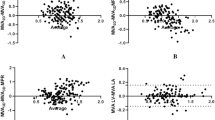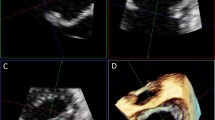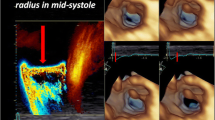Abstract
Rheumatoid valve disease is a general health problem of developing countries, and it mainly affects after the age of 40. Assessment of the correct mitral valve area (MVA) is important for the treatment of rheumatoid valve disease. However, there are contradictions between the three-dimensional (3D) and two-dimensional (2D) methods. A measurement with 3D echocardiography is a more accurate method to measure the MVA. However, in centers without 3D echocardiography, there are some difficulties in the accurate measurement of the MVA. The aim of this study was to assess the value of 2D transesophageal echocardiography (TEE) mitral valve vena contracta area (VCA) in predicting the severity of rheumatoid mitral stenosis (RMS) by comparing 3D planimetry. A total of 24 patients (10 females and 14 males) who were diagnosed with mild/moderate/severe RMS with using pressure half time, mean transmitral gradient, and planimetry methods were included in this study. 3D images were acquired using the 3D zoom and full volume. 2D TEE VCA was measured at an angle of 140° and 60°, which was perpendicular to the former, with color Doppler and the VCA was measured with an ellipsoid area using mathematical formula. There was statistically significant relationship between the measurements of 2D VCA and 3D zoom mode MVA planimetry and MVA full measurements (MVA full volume) (p < 0.01). Calculation of the valvular area after measuring the mitral valve VCA with 2D TEE is a reliable method that is usable in centers without 3D echocardiography.





Similar content being viewed by others
Change history
22 October 2019
In the original publication of the article one co-author, A. Zencirci, was listed by mistake. Dr. A. Zencirci has not contributed to this article and therefore, the author list has been updated. The author name A. Zencirci has been removed. All authors have agreed to the updated author list.
References
Marijon E, Ou P, Celermajer DS et al (2007) Prevalence of rheumatic heart disease detected by echocardiographic screening. N Engl J Med. 357(5):470–476
Vahanian A, Alfieri O, Andreotti F et al. Guidelines on the management of valvular heart disease (version 2012): the Joint Task Force on the Management of Valvular Heart Disease of the European Society of Cardiology (ESC) and the European Association for Cardio-Thoracic Surgery (EACTS). Eur J Cardiothorac Surg 42(4), S1–S44.
Thomas JP, Wilkins GT, Choong CY, Abascal VM (1988) Inaccuracy of mitral PHT immediately after percutaneous mitral balon valvulotomy Dependence on transmitral gradient and left atrial and left ventricular compliance. Circulation 78(4):980–993
Min SY, Song JM, Kim YJ, Park HK, Seo MO, Lee MS, Kim DH, Kang DH, Song JK (2013) Discrepancy between mitral valve areas measured by two-dimensional planimetry and three-dimensional transoesophageal echocardiography in patients with mitral stenosis. Heart 99:253–258
Karp K, Teien D, Bjerle P, Eriksson P (1989) Reassessment of valve area determinations in mitral stenosis by the pressure half-time method: impact of left ventricular stiffness and peak diastolic pressure difference. J Am Coll Cardiol 13(3):594–599
Carabello BA (1987) Advances in the hemodynamic assessment of stenotic cardiac valves. J Am Coll Cardiol 10(4):912–919
de Isla P, Casanova C, Almería C, Rodrigo JL, Cordeiro P, Mataix L, Aubele AL, Lang R, Zamorano JL (2007) Which method should be the reference method to evaluate the severity of rheumatic mitral stenosis? Gorlin's method versus 3D-echo. Eur J Echocardiogr 8:470–473
Zamorano J, Cordeiro P, Sugeng L, de Isla LP, Weinert L, Macaya C, Rodríguez E, Lang RM (2004) Real-time three-dimensional echocardiography for rheumatic mitral valve stenosis evaluation: an accurate and novel approach. J Am Coll Cardiol 43:2091–2096
Schlosshan D, Aggarwal G, Mathur G, Allan R, Cranney G (2011) Real-time 3D transesophageal echocardiography for the evaluation of rheumatic mitral stenosis. JACC Cardiovasc Imaging 4:580–588
Shashanka C, Rajasekhar D, Vanajakshamma V, Kumar ML (2013) Three-dimensional echocardiographic assessment before and after percutaneous transvenous mitral commissurotomy in patients with rheumatic mitral stenosis. J Heart Valve Dis 22:543–549
Lang RM, Badano LP, Tsang W et al (2012) American Society of Echocardiography; European Association of Echocardiography. EAE/ASE recommendations for image acquisition and display using three-dimensional echocardiography. Eur Heart J Cardiovasc Imaging 13(1):1–46
Gök G, Çınar T, Sayar N (2019) Quantification of rheumatic mitral stenosis severity with three-dimensional vena contracta area. Echocardiography 36(2):370–375
Henry WL, Griffith J, Michaelis LL et al (1975) Measurement of mitral orifice area in patients with mitral valve disease by real-time, two-dimensional echocardiography. Circulation 51(5):827–831
Kawahara T, Yamagishi M, Seo H, Mitani M, Nakatani S, Beppu S, Nagata S, Miyatake K (1991) Application of Doppler color flow imaging to determine valve area in mitral stenosis. J Am Coll Cardiol 18(1):85–92
Park T-H, Park M-A, Lee S-H, Cha K-S, Kim M-H, Kim Y-D (2006) Y-S Hong Measurement of vena contracta width for the assessment of severity of mitral stenosis. Heart Vessels 21:273–277
Abaci A, Oguzhan A, Unal S, Kiranatli B, Eryol NK, Basar E, Ergin A, Cetin S (2002) Application of the vena contracta method for the calculation of the mitral valve area in mitral stenosis. Cardiology 98(1–2):50–59
Author information
Authors and Affiliations
Corresponding author
Ethics declarations
Conflict of interest
All authors declare that they do not have conflict of interest.
Ethical approval
All procedures were performed in accordance with the ethical norms and standards of working.
Additional information
Publisher's Note
Springer Nature remains neutral with regard to jurisdictional claims in published maps and institutional affiliations.
Rights and permissions
About this article
Cite this article
Gok, G., Sayar, N., Oz, D. et al. Comparison of 2D vena contracta area with 3D planimetric mitral valve area in rheumatoid mitral valve disease. Int J Cardiovasc Imaging 36, 2115–2120 (2020). https://doi.org/10.1007/s10554-019-01673-y
Received:
Accepted:
Published:
Issue Date:
DOI: https://doi.org/10.1007/s10554-019-01673-y




